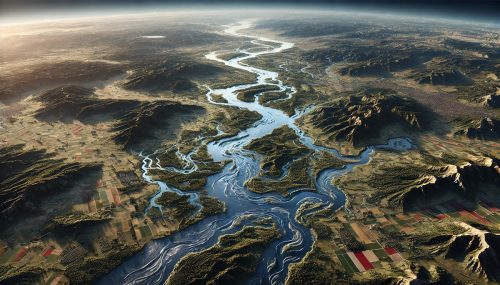Hungary Watershed Maps
Hungary Watershed Maps
We Build Custom 3D Watershed Maps
Hungary Watershed Maps: Managing Water Resources in the Heart of Europe
Hungary, a landlocked country in Central Europe, is known for its rich cultural history and diverse landscapes. However, it is also home to some of the most intricate water systems in the region, with numerous rivers, lakes, and wetlands. Hungary’s watersheds are crucial for the country’s agriculture, energy production, and water supply. Yet, these watersheds face a variety of challenges, including pollution, drought, and the effects of climate change. This blog explores the importance of Hungary’s watersheds, the role of watershed maps in managing water resources, and the key challenges and solutions for sustainable water management.
Geography and Hydrology: The Watershed Systems of Hungary
Hungary’s landscape is dominated by the Carpathian Mountains, the Great Hungarian Plain, and several large rivers that flow through the country. The primary watersheds of Hungary are centered around the Danube River, which is one of the longest and most significant rivers in Europe, and the Tisza River, which is the second-largest river in Hungary. Together, these rivers drain much of the country’s water into the Black Sea.
The Danube River flows through Hungary from the west to the southeast, passing through the capital city of Budapest. It is fed by numerous tributaries, including the Morava and Sava rivers. The Tisza River, which flows through the eastern part of Hungary, is another major watercourse that supplies water to a large portion of the country’s agricultural regions. Together, these river systems form the backbone of Hungary’s watersheds, providing water for agriculture, drinking, industry, and energy production.
In addition to rivers, Hungary is home to several significant lakes, including Lake Balaton, the largest freshwater lake in Central Europe. The country also has numerous smaller lakes and wetlands that support biodiversity and play a key role in water management.
Ecological and Agricultural Importance of Hungary’s Watersheds
Hungary’s watersheds are vital for maintaining ecological balance and supporting the country’s agricultural economy. The fertile plains of the Danube and Tisza river valleys are perfect for farming, with crops such as wheat, maize, and sunflowers being grown in abundance. Irrigation from these rivers is essential for crop production, particularly in the dry summer months.
The watersheds also support Hungary’s biodiversity. The Danube River and its tributaries are home to various fish species, including the Danube sturgeon and the European perch. Wetlands and lakes provide habitat for migratory birds, while forests and riparian zones along the riverbanks support a variety of plant and animal species. The preservation of these ecosystems is crucial for maintaining Hungary’s rich biodiversity and ensuring the continued availability of freshwater resources.
Furthermore, Hungary’s watersheds are important for energy production, particularly through hydropower. Several hydroelectric plants are located along the Danube and Tisza rivers, providing a renewable source of energy for the country. This makes the health of Hungary’s watersheds not only important for environmental sustainability but also for economic development.
Challenges Facing Hungary’s Watersheds
Despite their ecological and economic importance, Hungary’s watersheds face several significant challenges. Pollution is one of the most pressing issues, particularly in the Danube and Tisza rivers. Agricultural runoff, industrial waste, and untreated sewage contribute to the contamination of water resources, reducing water quality and harming aquatic ecosystems. Eutrophication, caused by excessive nutrients in the water, has led to the overgrowth of algae and the depletion of oxygen in certain parts of the rivers and lakes.
Another challenge is the increasing frequency of droughts, particularly in the Great Hungarian Plain. The country has been experiencing more extreme weather events, including dry periods during the summer and heavy rainfall during the winter. These shifts in precipitation patterns are linked to climate change and pose a significant threat to water availability for agriculture and other uses.
In addition to these challenges, Hungary faces pressure from urbanization and industrial development, which often leads to increased demand for water. The expansion of cities, particularly in the Danube River basin, has led to over-extraction of water resources and pollution, further stressing the country’s watersheds.
The Role of Watershed Maps in Hungary’s Water Resource Management
Watershed maps play a crucial role in understanding the movement and distribution of water across Hungary’s landscape. These maps help policymakers, water managers, and environmental scientists track the health of rivers, lakes, and wetlands, as well as identify areas at risk from pollution, drought, or flooding. By using Geographic Information Systems (GIS), watershed maps provide detailed information about the topography, hydrology, and land use patterns within each watershed.
In Hungary, watershed maps are used to manage water quality and quantity, helping to allocate water resources for agriculture, industry, and domestic use. These maps also help to predict flood risks, allowing for better disaster preparedness and the construction of flood control infrastructure. Watershed maps can also help in monitoring the impact of climate change on water availability, enabling water managers to take proactive steps to address water scarcity during dry periods.
By mapping the sources of pollution, authorities can target areas that need intervention and implement strategies to reduce contaminants entering the water systems. Sustainable land use practices, improved wastewater treatment facilities, and the promotion of agricultural best practices are some of the solutions that can be implemented based on insights gained from watershed maps.
The Fabrication of 3D Watershed Maps for Hungary
The process of creating 3D watershed maps for Hungary begins with the collection of topographical and hydrological data. Satellite imagery, aerial surveys, and ground-based measurements are used to capture the elevation and terrain of the country’s rivers and watersheds. This data is then processed into a detailed digital model of Hungary’s landscape.
Hydrological data, including river flow rates, rainfall patterns, and water quality indicators, are incorporated into the model. This allows for the simulation of how water moves through the watersheds, helping water managers predict the effects of different scenarios, such as drought or flood events. The 3D maps provide a more realistic representation of how water interacts with the landscape, making it easier for decision-makers to understand the impact of various factors on water resources.
3D watershed maps also allow for better public engagement and education. Local communities, farmers, and stakeholders can use these maps to better understand the challenges facing their water resources and contribute to water conservation efforts. By visualizing the terrain and water systems, communities are more likely to recognize the importance of preserving water resources for future generations.
Conservation and Sustainability Efforts for Hungary’s Watersheds
Conserving and sustainably managing Hungary’s watersheds is essential for the country’s long-term ecological health and economic prosperity. Efforts to protect these watersheds focus on reducing pollution, improving water quality, and restoring degraded ecosystems. Hungary has implemented several conservation programs aimed at protecting wetlands, forests, and riparian zones along the country’s rivers.
In addition to conservation efforts, Hungary is working to improve water management practices in agriculture. By promoting sustainable farming methods, such as precision irrigation and organic farming, the country can reduce the impact of agricultural runoff on water quality. Reforestation and afforestation projects are also critical to preventing soil erosion and improving the water retention capacity of the land.
Looking to the future, Hungary will need to continue adapting to the challenges posed by climate change, population growth, and industrial development. By integrating modern technologies like 3D watershed maps into its water management practices, Hungary can ensure that its watersheds remain healthy and continue to provide essential resources for its people and economy.
Check out WhiteClouds’ 3D Maps for more information on Hungary watershed maps.

